|
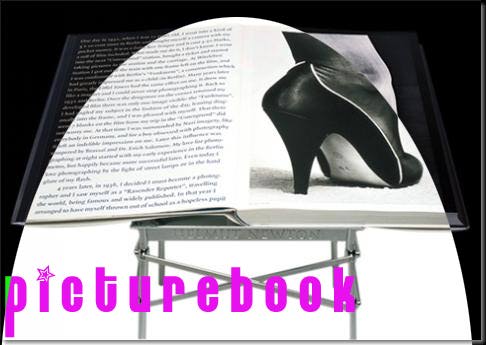
Literary Iconoclasts, Cinematic Bibliophiles, & Other Pathological Textual Fetishists
Fall 1998 SDSU
T/TH 9:30 TO 10:45AM IN
THE IMAGINATION ASYLUM,
AKA CHEM/GEO 302
Dr. William A. Nericcio
Introduction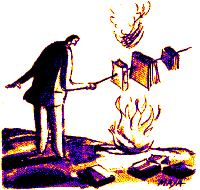
"Picture." "Book." It would seem so simple to talk about pictures and books--it’s how you and I learned to read. But it is those most easiest and immediate concepts that end up needing the most dedicated re-investigation. Images and Words, pictures and books--from the start, we will have trouble understanding where to begin, where to end. And yet I have selected these two words and asked them to serve as our guides as we introduce ourselves to the study of literature. Consider the following: both "picture" and "book" are at once nouns and verbs--one can picture a book, as well as book a picture. This peculiar interchangeability is a key trait of our analytical adventure this semester; it is, in short, the essence of our critical endeavour these last few months of 1998.The literary domain (the home of books) and the graphical realm (the playground of pictures) have everything to do with one another: this is as true of traditional masterworks like William Blake’s Urizen Books and William Faulkners’s The Sound and the Fury as it is contemporary graphic novels by Daniel Clowes which are part of our 16-week adventure.
So pictures and books, simple; well, not at all. For in the 20th century pictures have been on the march. With the advent and popularization of photography, of cinema and, especially, television, "Pictures" have proliferated to the point that imagining literature without some sort of visual supplement is becoming damn near impossible. So this class will literally and figuratively venture to think about the relationship of books and pictures. I say literally because several of our texts are picturebooks, images form an essential part of the narrative. I say "figuratively" because the affairs and intrigues of pictures and books will at times provide the organizing principal for our films and stories: in Atom Egoyan’s The Sweet Hereafter, a child’s fairy tale book provides the key to the film’s narrative organization--it propels its themes, it underwrites its meaning. Similarly, Norma Cantú’s Canícula and Junichiro Tanizaki’s The Key, while prose novels n the strict sense, are also, at once, photo albums, or, more generally, narratives where the line between word and image is purposely blurred so as to drive the engine of the narrative.
Pictures. Books. And films to boot. Bodies of Ink, bodies of light, bodies that move, bodies that touch and leave the other altered, changed, aroused, disturbed. It will be my pleasure to introduce you to the contentious, iconoclastic world of literature.
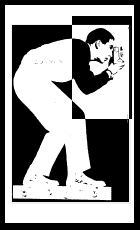
Attendance
The whole point of this class is to work together, the idea being that we somehow convert our sad, decaying lecture hall into an chaotic, intellectual laboratory. If you miss class, you are missing the whole point of the adventure. As such, miss no more than three classes (3) during the semester; note that you are responsible for any work which you miss or assignments you elect to ‘bail on.’ One last unpleasant matter: if you miss more than three sessions, you will be dropped from the class.When you walk into class each day on time, you will have read all that has been assigned to you for that day. There are no excuses for missed preparation as reading assignments for a given day are clearly stated in your course calendar. This may strike you as a bit harsh but the rule is quite simple: If you do not prepare the readings, you are not welcome in class. Why? Because this seminar depends upon the contributions of its participants--without your input, the class is likely to evolve into a boring, one and one-quarter hour waste of life. With your help, we can avoid this.
Writing and Examinations
You will be asked to write two brief analytical imagination challenges (2-5 pages typed). There will also be several in-class panic-inducing writing exercises. Note, that you will never be compelled to write about something you totally dislike--if you are ever asked to write about something which turns you off, please see me during office hours and we will brainstorm a substitute assignment.
Quizzes
You can expect an unannounced quiz or in-class writing assignment from time to time: the number of quizzes will depend on how many of you still get off to the idea that you are still in high school. In other words, if everyone acts like a talented university undergraduate, there will not be a quiz during the semester.
Office Hours
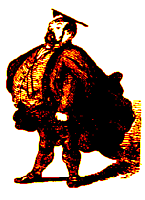
Why ‘office hours’? I expect you to visit Jeff Staley or myself in office hours at least once during the semester. In a class like ours it will be too easy to fall through the cracks, to feel that you are nothing but a number or some warm pile of flesh filling a seat. In order to understand that the individuals teaching you are somewhat human, please make a point of letting us meet you personally. Bill Nericcio’s office hours are from 11 to 1pm on Tuesdays in Adams Humanities 4117; Mr Staley will post his hours shortly--he will hold their office hours in Adams Humanities 4179; you can leave him a message at 594.6711. If these hours are inconvenient, do not hesitate to call me at 594.1524 either to schedule an appointment or discuss your questions via telephone.
Grading Information
40% Attendance, In-class "Panic" Challenges, Class Participation
40% Analytical Imagination Challenges...aka "Essays"
29% Final Thinking Challenge Exercise
1% Chutzpah, ganas, will, driveRequired readings available at KB, FTX and/or Aztec Shops Campus store: Shop around for the best prices.
Art Spiegelman Maus II
Junichiro Tanizaki The Key
Daniel Clowes Ghost World
Norma Elia Cantú Canícula
Scholastic (K. Reagan et al.)The History of Making Books
Chronicle (Anonymous) The Sex Box
Juan Felipe Herrera Love After the Riots
Toni Morrison Jazz
Mary Wollstonecraft Shelley Frankenstein or The Modern Prometheus
Arturo Islas The Rain GodRequired Films screened for free in-class.
"You should look straight at a film; that's the only way to see one. Film is not the art of scholars but of illiterates."
Werner Herzog (b. 1942) German film director. New York Times (11 Sept. 1977)Peter Greenaway The Pillow Book
Atom Egoyan The Sweet HereafterOptional Films screened for standard movie fee ($7ish) at the Ken Cinema, 4061 Adams Avenue in the heart of Kensington, west of campus. Screening time information at 283.5909. Good extra credit opportunity.
Federico Fellini 8 1/2 September 4 and 5
William Anthony Nericcio
Associate Professor

DAY TO DAY MENU
Tuesday, September 1

PictureBook©: an introduction: wherein we discover that there is much more to reading than was suggested by Dick and Jane--or, in other words, Dick and Jane were up to more than we gave them credit. Chaos reigns as over a hundred undergraduates decide to dedicate close to half a year to the serious analysis of literature, graphic narrative and film. A bit of a lecture about pictures, books and literature. Hermeneutic Subsidy: "hermeneutic subsidy," and "iconoclast."
Thursday, September 3
Read the first two chapters of Maus II, A Survivor’s Tale: And Here My Troubles Began. Read these chapters twice: the first time, "normally," as you would any comic, words and pictures at once. The second time, "read" only the pictures, ignoring the words as you sample Spiegelman’s disturbing biography of his father. Hermeneutic Subsidy: "autobiography," "biography," "-graphy."
Tuesday, September 8

Finish reading Spiegelman’s Maus II. Consider how this book is and is not at once a classic Picturebook--the tale is drawn, the animals are talking and yet this is anything but a book you would find next to Alice in Wonderland at Babys-R-US. What is the difference, and why does Spiegelman adopt this form? Hermeneutic Subsidy: "genre."
Thursday, September 10
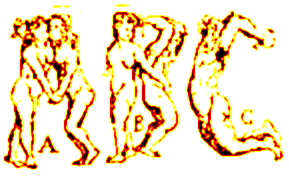
Read Scholastic Inc.’s The History of Making Books by André Beguín, Katherine Reagan and others. Here we learn that the history of the book in human culture is bound up in the odd, unpredictable cohabitations of pictures and words--in the past and in the present. In class, we will conclude our discussion of Maus II and, using ‘Making Books, begin to think about some of the general characteristics of literature. Hermeneutic Subsidy: "type." In-class Imagination Panic Attack Inducing Exercise, likely.
Tuesday, September 15
Read to the end of the April 10 diary entry in Junichiro Tanizaki’s The Key.We continue studying the issue of pictures and books, only here the "pictures" are nasty Polaroids, the "books" a philandering wife’s and peculiar husband’s "secret" diaries. Hermeneutic Subsidy: "intertextuality."
Thursday, September 17
Read to page 142 in Tanizaki’s The Key--keep a keen eye trained on each of Ikuko and her professor-husband’s diary entries; and try not to be too fooled--the entries are not always "true." That is, always be aware you may be reading the jottings of a deceitful narrator. Hermeneutic Subsidy: "narrative point of view."
Tuesday, September 22
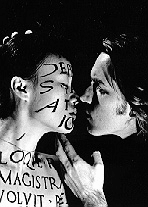
Today you will walk into our soon to be condemned classroom, our very own Imagination Laboratory (aka, the Asbestos Hotel) having finished Tanizaki’s The Key. Discussion to follow, right? Wrong. Instead we will open our eyes to the visually challenging and erotically graphic cinematic picturebook of Peter Greenaway, The Pillow Book. Do note that the film contains adult materials and issues, it is also rather graphic, and some viewers have found parts of it a bit disturbing. So, brace yourself. Hermeneutic Subsidy: "film theory."
Thursday, September 24
We will finish screening Greenaway’s cinematic opus today. Afterwards, we will discuss both Tanizaki’s book and Greenaway’s movie. How does the Japanese novelist’s writing help us to see new levels of meaning in Greenaway’s film? How does Greenaway’s movie allow us to "re-read" Tanizaki’s novel in a different way? Hermeneutic Subsidy: "analysis."
Tuesday, September 29

Read to the end of page 113 in Toni Morrison’s Jazz. That’s a chunk of reading you might at first say glancing at the page number--but it’s tasty reading, intoxicating reading. Morrison, our Nobel prize winning American master of fiction, will keep you turning the pages in this feisty, disturbing novel. Receive Analytical Imagination Challenge #1. Hermeneutic Subsidy: "refraction."
Thursday, October 1
Picturebook© and Jazz what’s the connection? Oh, nothing really, especially if you don’t keep your eyes peeled for references to a photograph that is hiding at the heart of this throbbing tale of jealousy, love, fear and betrayal. Read to page 135 for today’s discussion. Hermeneutic Subsidy: "Frame."
Tuesday, October 6
Over the weekend and before you saunter into Chem/Geo 302, finish reading Morrison’s fiery novel. How does Morrison’s prose compare to other writers you have read this semester? Hermeneutic Subsidy: "post-modernism."
Thursday, October 8
Picturebook© defined. Norma Cantú’s Canícula is clearly a book designed for our peculiar, if gifted collective--read/look up to page 39. Here is a "novel"/"autobiography" that doubles as a photo-album, or foto-novela, take your pick. Watch closely as Cantú weaves her tale: do her words serve as captions for her photographs or are her pictures serving as captions for her words? Hermeneutic Subsidy: "palimpsest."
Tuesday, October 13
Read pages 40 to 104 in Cantú’s Canícula--if photographs are one obsession of this Southwest American writer, memory is clearly another. What is the relationship between the phenomenon called "memory" and that ubiquitous invention, photography? Hermeneutic Subsidy: "semiotics."
Thursday, October 15

Celebrity-day. Author Norma Cantú leaves her darkroom long enough to jet to San Diego to treat us to a reading from Canícula and from a work-in-progress. After her readings she will field questions from our collective. Bring a friend/meet a novelist! Hermeneutic Subsidy: "celebrity."
Tuesday, October 20
Have you ever heard the story of the Pied Piper of Hamelin? You know, rats, piper, kids, tragedy. Well, imagine you are a film director obsessed with the story but, also, unsatisfied with it? The result might be something like Atom Egoyan’s striking The Sweet Hereafter which we will begin to screen today in class. This is no fairy tale. But, then, come to think about it, neither were those fairy tales. Hermeneutic Subsidy: "Children’s Literature."
Thursday, October 22
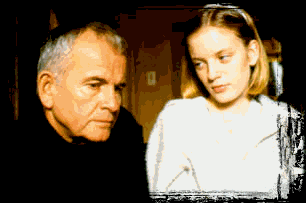
We will complete our screening of Egoyan’s micro masterpiece. In class discussion we will consider how the film re-writes the classic tale of a piper and his mindless ditty-intoxicated kiddies into a study of tragedy and melancholy in a small town. Note that tomorrow, Friday October 23, your Analytical Imagination Challenge #1 is due at noon, under the door of my office, 4117 Adams Hum. Hermeneutic Subsidy: "tragedy."
Tuesday, October 27
Shelley’s Frankenstein, not Hollywood’s. Brace yourself for a surprise--a delightful one, a disturbing one. Shelley’s striking novel is less a story of monsters and mad scientists and more a sobering assault on the dangers of reading. Read up to page 85 for today’s class. Hermeneutic Subsidy: "Prometheus."
Thursday, October 29

Read up to page 140 in this illustrated version of Shelley’s story. As you read, note how the designer/illustrator Barry Moser attempts to echo the shades of the novel with the blackness of his illustrations and typography. Hermeneutic Subsidy: "monster."
Tuesday, November 3
Read to the bottom of page 213. For today’s class, our discussion will focus upon the peculiar character of Victor Frankenstein, the "scientist" who discovers the secret of reanimating human life, only to abandon his creation almost immediately. In-class Imagination Panic Inducing Exercise, likely. Hermeneutic Subsidy: "Paradise Lost," "John Milton."
Thursday, November 5
It ends today, Frankenstein does and it is worth taking the time to congratulate yourself for actually having read a novel that everybody has heard of and almost nobody has ever read. It is less a story of monsters, than an exposé of that most common monster, "man." It also shows what could happen to you if you read books without analytical acumen. Receive Analytical Imagination Challenge #2.
Tuesday, November 10
We now dive headlong into the melancholic and lyric words of Arturo Islas--read up to page 98 of Islas’s The Rain God. As usual, keep a sharp eye out for literal and figurative references to pictures, more specifically, to photographs. Not for nothing does Islas build his tale around the obsessions of his protagonist with a singular photograph. Hermeneutic Subsidy: "melancholy."
Thursday, November 12
Read pages 98 to 138 in Islas’s border tale. Border tale, here, is a loaded term because the border itself, both literal and imaginative weaves its way throughout this thoughtful novel. Pay particular attention to the relationships between family members in the novel. Hermeneutic Subsidy: "la quiebra."
Tuesday, November 17
Finish reading Islas’s The Rain God. In class, we will complete our discussion of the novel; in addition, we will attempt to compare and contrast Islas’s aesthetic project with other works we have consumed this semester. Hermeneutic Subsidy: "Comparative Literature."
Thursday, November 19
Hey, good-bye for awhile. Next week we will be off as your ringleader jets to London to give a lecture. To celebrate we will read the shortest book of the semester--shortest, not easiest. Today, we sample the poetic talents of Juan Felipe Herrera and Love After the Riots. One part TV, one part Cinema and poetry through and through, Herrera’s evocative poetry recasts our recent LA Rebellion/Riots as a micro-epic lyric. Note that Analytical Imagination Challenge #2 is due tomorrow, Friday, November 20 at noon under my door AH 4117. Hermeneutic Subsidy: "Rebellion."
Tuesday, November 24
Pre-Thanksgiving Break Break; Hermeneutic Subsidy: "freedom."
Thursday, November 26
Have a Great Thanksgiving Break!!! Hermeneutic Subsidy: "mass quantities of food."
Tuesday, December 1
The Sex Box is an anthology. But this is no Norton’s Anthology of Literature--the emphasis here is on sex. But it is more than that, of course. As this particular anthology "boxes" together a veritable who’s who of celebrity authors new, old and ancient. For today’s class, walk into the room having read the Man and Woman volumes. Be prepared to discuss what you view to be significant similarities and differences between the genders when it comes to the literary treatment of sexuality. Hermeneutic Subsidy: "pornography."
Thursday, December 3
Complete your reading of The Sex Box. Read the Sex volume for today’s potentially highly charged discussion. Is erotic literature different than Literature proper--or is it that Shakespeare just seems a whole lot safer? Hermeneutic Subsidy: "Body of Ink."
Tuesday, December 8

End of the show, almost. Walk into class having carefully read/screened Daniel Clowes’s Ghost World. As with Maus II, read the volume twice, the second time ignoring the words and screening only the pictures. You have come a long way in the "reading" of picturebooks since September 1--how is Clowes work similar to Spiegelman’s; how is it wholly different. Hermeneutic Subsidy: "irony."
Thursday, December 10
Today, the party ends, the book closes, the picture turns to black. In-class final. Party?